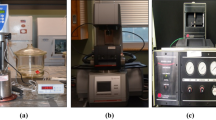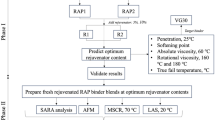Abstract
Transportation agencies are increasingly incorporating reclaimed asphalt pavement (RAP) in asphalt mixtures due to the scarcity and increased costs of virgin resources. The usage of RAP brings both economic as well as environmental benefits. Nonetheless, because RAP is an aged, stiff, and brittle material, utilizing it in large quantities can make the pavement more prone to cracking and reduce its service life. Recycling agents (rejuvenators) are additives typically applied to partially restore the properties of aged asphalt binders and facilitate using higher RAP contents. While considerable effort has been made on evaluating the influences of recycling agents on asphalt binders’ performance, the rejuvenation mechanisms of recycling agents have not yet been thoroughly examined. This study's objective was to evaluate the influence of various types of recycling agents on the properties of asphalt binder blends containing 50% RAP binder. The oxidative stability of the recycling agents and rejuvenated binder blends was evaluated utilizing thermogravimetric analysis (TGA). The glass transition region and the compatibility of the binder blends were assessed using differential scanning calorimetry (DSC). Finally, atomic force microscopy (AFM) experiments were conducted to study the mechanisms of the recycling agents at the nanoscale level. The results revealed a relationship between the phases detected in the microstructure and the physical characteristics of the binder blends. DSC analysis showed that after the inclusion of recycling agents, the breadth and temperature of the glass transition region were reduced, indicating the formation of a less brittle material. AFM observations showed that the dispersion of the polar molecular associations in the RAP binder correlated with the changes in the glass transition region as measured using the DSC. The study's findings were used to characterize the effectiveness of recycling agents based on the thermal, microstructural, and rheological properties of rejuvenated binder blends to help explain the mechanisms of recycling agents.










Similar content being viewed by others
References
Shen J, Amirkhanian S, Aune Miller J (2007) Effects of rejuvenating agents on superpave mixtures containing reclaimed asphalt pavement. J Mater Civ Eng 19(5):376–384
Zaumanis M, Mallick RB, Poulikakos L, Frank R (2014) Influence of six rejuvenators on the performance properties of Reclaimed Asphalt Pavement (RAP) binder and 100% recycled asphalt mixtures. Constr Build Mater 71:538–550
Yin F, Kaseer F, Arámbula-Mercado E, Epps Martin A (2017) Characterising the long-term rejuvenating effectiveness of recycling agents on asphalt binder blends and mixtures with high RAP and RAS contents. Road Mater Pavement Des 18(sup4):273–292
Menapace I, Cucalon LG, Kaseer F, Arámbula-Mercado E, Martin AE, Masad E, King G (2018) Effect of recycling agents in recycled asphalt binders observed with microstructural and rheological tests. Constr Build Mater 158:61–74
Kaseer F, Arámbula-Mercado E, Cucalon LG, Martin AE (2020) Performance of asphalt mixtures with high recycled materials content and recycling agents. Int J Pavement Eng 21(7):863–877
Rajib AI, Samieadel A, Zalghout A, Kaloush KE, Sharma BK, Fini EH (2020) Do all rejuvenators improve asphalt performance? Road Mater Pavement Des 23(2):358–376
Abdelaziz A, Epps Martin A, Masad E, Arámbula Mercado E, Kaseer F (2020a) Effects of ageing and recycling agents on the multiscale properties of binders with high RAP contents. Int J Pavement Eng 23(4):1248–1270
Cavalli MC, Mazza E, Zaumanis M, Poulikakos LD (2021) Surface nanomechanical properties of bio-modified reclaimed asphalt binder. Road Mater Pavement Design 22(6):1407–1423
Elkashef M, Elwardany MD, Liang Y, Jones D, Harvey J, Bolton ND, Planche JP (2020) Effect of using rejuvenators on the chemical, thermal, and rheological properties of asphalt binders. Energy Fuels 34(2):2152–2159
De Lira RR, Cortes DD, Pasten C (2015) Reclaimed asphalt binder aging and its implications in the management of RAP stockpiles. Constr Build Mater 101:611–616
McCarron, B., Yu, X., Tao, M., & Burnham, N. (2012). The Investigation of “Bee-Structures” In: Asphalt Binders. Qualifying Project. Worcester, MA
Apostolidis P, Liu X, Kasbergen C, Scarpas AT (2017) Synthesis of asphalt binder aging and the state of the art of antiaging technologies. Transp Res Rec 2633(1):147–153
Hofko B, Handle F, Eberhardsteiner L, Hospodka M, Blab R, Füssl J, Grothe H (2015) Alternative approach toward the aging of asphalt binder. Transp Res Rec 2505(1):24–31
Kaseer F, AE Martin, E Arámbula-Mercado (2019) Use of recycling agents in asphalt mixtures with high recycled materials con- tents in the United States: A literature review. Constr Build Mater 211: 974–987. https://doi.org/10.1016/j.conbuildmat.2019.03.286
Elkashef M, Williams RC, Cochran EW (2018) Physical and chemical characterization of rejuvenated reclaimed asphalt pavement (RAP) binders using rheology testing and pyrolysis gas chromatography-mass spectrometry. Mater Struct 51(1):1–9
Elkashef M, Podolsky J, Williams RC, Cochran E (2017) Preliminary examination of soybean oil derived material as a potential rejuvenator through Superpave criteria and asphalt bitumen rheology. Constr Build Mater 149:826–836
Garcia Cucalon L, King G, Kaseer F, Arambula-Mercado E, Epps Martin A, Turner TF, Glover CJ (2017) Compatibility of recycled binder binder blends with recycling agents: rheological and physicochemical evaluation of rejuvenation and aging processes. Ind Eng Chem Res 56(29):8375–8384
Elkashef M, Jones D, Jiao L, Williams RC, Harvey J (2019) Using thermal analytical techniques to study rejuvenators and rejuvenated reclaimed asphalt pavement binders. Energy Fuels 33(4):2651–2658
Elkashef M, Williams RC, Cochran EW (2019) Thermal and cold flow properties of bio-derived rejuvenators and their impact on the properties of rejuvenated asphalt binders. Thermochim Acta 671:48–53
Verdonck E, Schaap K, Thomas LC (1999) A discussion of the principles and applications of modulated temperature DSC (MTDSC). Int J Pharm 192(1):3–20
Daoudi A, Dony ACarter A, Ziyani L, & Perraton D (2020) Combined recycling of RAS and RAP: Experimental and modeling approach. In: RILEM International Symposium on Bituminous Materials. Springer, Cham, pp. 387–393
Huang SC, Grimes W, & Qin Q (2015) Rejuvenator for enhancing RAP applications and improving materials compatibility: fundamental properties of asphalts and modified asphalt III: FP 16. Technical White Paper, Western Institute March
Holleran I, Masad E, Holleran G, Wubulikasimu Y, Malmstrom J, Wilson DJ (2021) Nanomechanical mapping of rejuvenated asphalt binders. Road Mater Pavement Des 22(11):2478–2497
Abdelaziz A, Masad E, Epps Martin A, Arámbula Mercado E, & Bajaj A (2021) Forthcoming Multiscale Characterization of Aging and Rejuvenation in Asphalt Binder blends with High RAP Contents. J Mater Civil Eng. https://doi.org/10.1061/(ASCE)MT.1943-5533.0003910
Hossain Z, Rashid F, & Roy S (2018) Multiscale evaluation of rejuvenated asphalt binders with a high RAP content (No. 18–06281)
Rashid AF (2016) Multiscale mechanistic characterization of reclaimed asphalt pavements. Arkansas State University
Abdelaziz A, Martin AE, Masad E, Arámbula-Mercado E, & Kaseer F (2020b) Effect of recycling agents on the homogeneity of high RAP binders. In Advances in Materials and Pavement Performance Prediction II: Contributions to the 2nd International Conference on Advances in Materials and Pavement Performance Prediction (AM3P 2020), 27–29 May 2020, San Antonio, TX, USA (p. 243). CRC Press
Mirwald J, Werkovits S, Camargo I, Maschauer D, Hofko B, Grothe H (2020) Understanding bitumen ageing by investigation of its polarity fractions. Constr Build Mater 250:118809
Eyssautier J, Levitz P, Espinat D, Jestin J, Gummel J, Grillo I, Barré L (2011) Insight into asphaltene nanoaggregate structure inferred by small angle neutron and X-ray scattering. J Phys Chem B 115(21):6827–6837
Martin, AE, Kaseer F, Arambula-Mercado E, Bajaj A, Cucalon LG, Yin F, & King G (2019) Evaluating the effects of recycling agents on asphalt mixtures with high RAS and RAP binder ratios. NCHRP Research Report (927)
Bajaj A, Martin AE, King G, Glover C, Kaseer F, Arámbula-Mercado E (2020) Evaluation and classification of recycling agents for asphalt binders. Constru Build Mater 260:119864
Arámbula-Mercado E, Kaseer F, Epps Martin A, Yin F, Garcia Cucalon L (2018) Evaluation of recycling agent dosage selection and incorporation methods for Asphalt Mixtures with High RAP and RAS Contents. Constr Build Mater 158:432–442
Glover CJ, Davison RR, Domke CH, Ruan Y, Juristyarini P, Knorr DB, Jung SH (2005) Development of a new method for assessing asphalt binder durability with field validation. Texas Dept Transport 1872:1–334
Kandhal PS (1977) Low-temperature ductility in relation to pavement performance. In: Marek CR (ed) Low-temperature properties of bituminous materials and compacted bituminous paving mixtures. ASTM STP 628. American Society for Testing and Materials, pp. 95–106
Bennert T, Haas E, Ericson C, Wass Jr E (2019) Evaluation of Overlay Tester Test Procedure to Identify Fatigue Cracking Prone Asphalt Mixtures (No. CAIT-UTC-NC57). Rutgers University. Center for Advanced Infrastructure and Transportation
Anderson RM, King GN, Hanson DI, Blankenship PB (2011) Evaluation of the relationship between asphalt binder properties and non-load related cracking. J Assoc Asphalt Paving Technol 80:615–664
Jiang Y, Zhao R, Xi Z, Cai J, Yuan Z, Zhang J, Xie H (2021) Improving toughness of epoxy asphalt binder with reactive epoxidized SBS. Mater Struct 54(4):1–17
Kriz P, Stastna J, Zanzotto L (2008) Glass transition and phase stability in asphalt binders. Road Mater Pavement Des 9(sup1):37–65
Robertson, R. E., Branthaver, J. F., Plancher, H. E. N. R. Y., Duvall, J. J., Ensley, E. K., Harnsberger, P. M., & Petersen, J. C. (1991). Chemical properties of asphalts and their relationship to pavement performance (No. SHRP-A/UWP-91–510). Washington, DC: Strategic Highway Research Program, National Research Council
Jones DR (1992) Understanding how the origin and composition of paving-grade asphalt cements affect their performance. SHRP, Asphalt Research Tech. Univ. of Texas at Austin, Texas. Memo (4)
Song M, Hourston DJ, Schafer FU, Pollock HM, Hammiche A (1998) Modulated differential scanning calorimetry: XVI. Degree of mixing in interpenetrating polymer networks. Thermochim acta 315(1):25–32
Hung AM, Fini EH (2015) AFM study of asphalt binder “bee” structures: origin, mechanical fracture, topological evolution, and experimental artifacts. RSC Adv 5(117):96972–96982
Zhang H, Wang Y, Yu T, Liu Z (2020) Microstructural characteristics of differently aged asphalt samples based on atomic force microscopy (AFM). Constru Build Mater 255:119388
Pauli AT, Robertson RE, Eggleston CM, Branthaver JF, Grimes W (2001) Atomic force microscopy investigation of SHRP asphalts. Am Chem Soc Div Petrol Chem 46(2):104–110
Loeber L, Sutton O, Morel JVJM, Valleton JM, Muller G (1996) New direct observations of asphalts and asphalt binders by scanning electron microscopy and atomic force microscopy. J Microsc 182(1):32–39
Jäger A, Lackner R, Eisenmenger-Sittner C, Blab R (2004) Identification of four material phases in bitumen by atomic force microscopy. Road Mater Pavement Des 5(sup1):9–24
Hofko B, Eberhardsteiner L, Füssl J, Grothe H, Handle F, Hospodka M, Scarpas A (2016) Impact of maltene and asphaltene fraction on mechanical behavior and microstructure of bitumen. Mater Struct 49(3):829–841
Schmets A, Kringos N, Pauli T, Redelius P, Scarpas T (2010) On the existence of wax-induced phase separation in bitumen. Int J Pavement Eng 11(6):555–563
Pipintakos G, Blom J, Soenen H (2021) Coupling AFM and CLSM to investigate the effect of ageing on the bee structures of bitumen. Micron 151:103149
Soenen H, Besamusca J, Fischer HR, Poulikakos LD, Planche JP, Das PK, Chailleux E (2014) Laboratory investigation of bitumen based on round robin DSC and AFM tests. Mater Struct 47(7):1205–1220
Rasband W1 (1997) ImageJ. Bethesda, MD: US National Institutes of Health
Author information
Authors and Affiliations
Corresponding author
Ethics declarations
Conflict of interest
The authors declare that they have no conflict of interest.
Additional information
Publisher's Note
Springer Nature remains neutral with regard to jurisdictional claims in published maps and institutional affiliations.
Rights and permissions
About this article
Cite this article
Abdelaziz, A., Masad, E., Epps Martin, A. et al. Thermal, microscopic, and rheological characterization of rejuvenated asphalt binders. Mater Struct 55, 98 (2022). https://doi.org/10.1617/s11527-022-01946-4
Received:
Accepted:
Published:
DOI: https://doi.org/10.1617/s11527-022-01946-4




